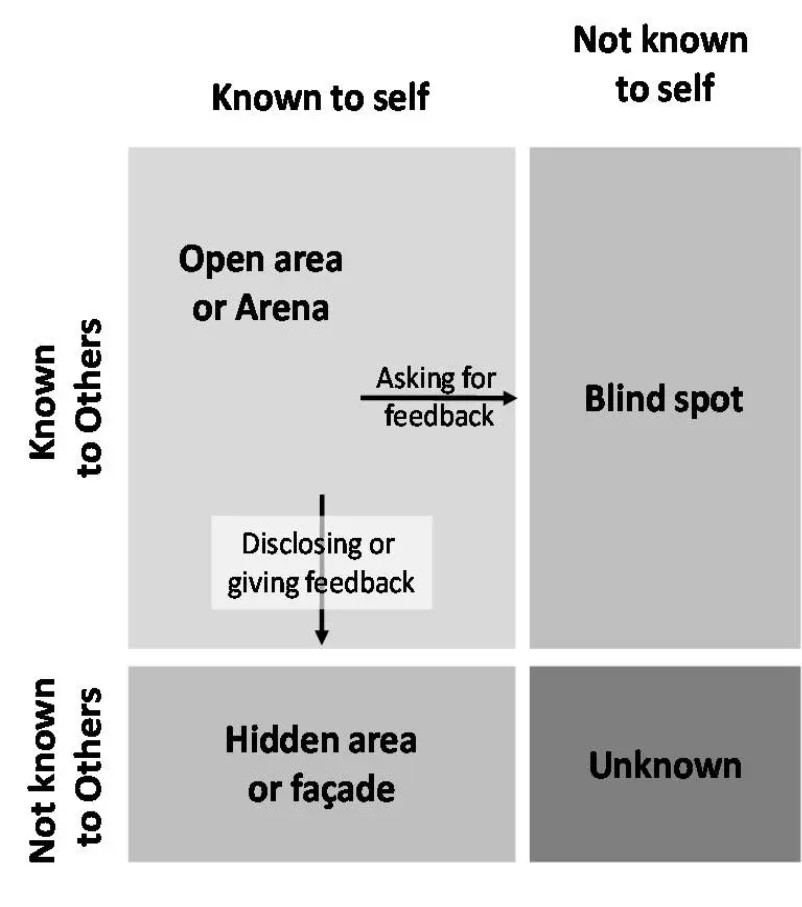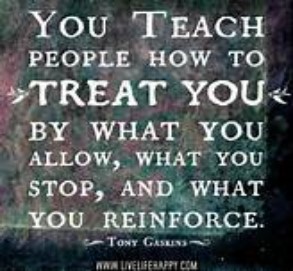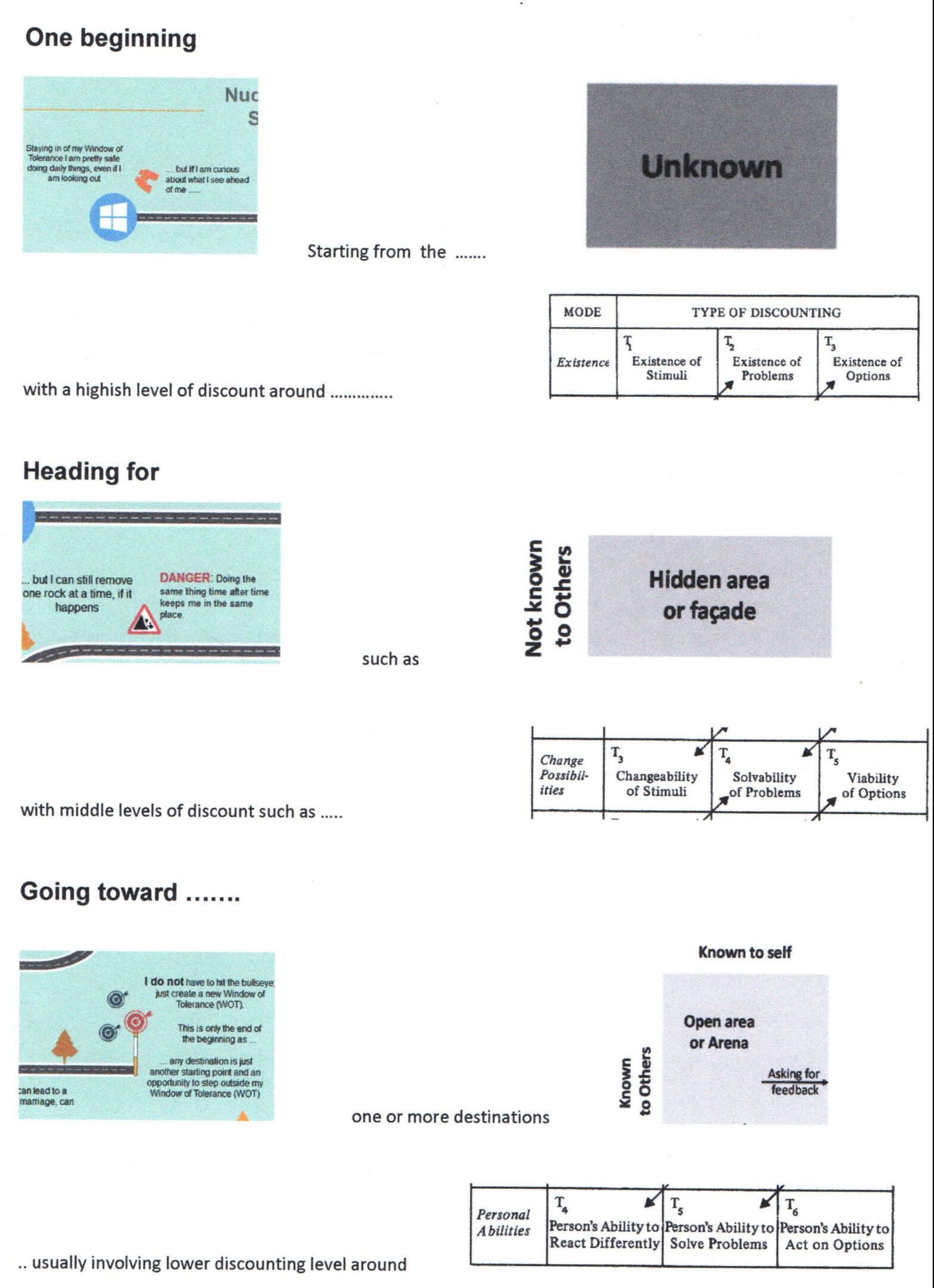HEALTH WARNING: On this page I am offering you my own opinion. It is my interpretation of a series of events. My lived experience can lead me into cul de sacs, same as any one else – even if this page is illustrated by examples provided by the client with a different lived experience. Together, we offer just one way to look at something that did happen.
My picture, above, is my summary. It summarises three pages I have returned to a good few times on this website:
….. and the page on the processes of adult learning may help.
Each element, when put together, may describe how therapy can proceed; from one beginning, to another beginning and from one understanding, toward another, and another.
You may find a way to use our understanding – in your own situation.
I return to the Discount Matrix
As I have said, elsewhere, using the Discount Matrix involves a trip from the bottom right to top left.
- from the ‘easiest’ bit – things that may be just within our reach;
- to the hardest bit, when we do not accept there is a problem at all.
That ‘hardest’ bit presents a large problem: how do humans best find out what they need to know, but, on some occasions, keep it behind their facade or in their own blind spot?
Here is an example of how the Discount Matrix can apply in work with a client over many months.
I find it interesting as it addresses the question: who is right? Who says what is right? How do you, the reader, ensure you stay in charge of the process of change?
As ever, please come back to the hyperlinks to identify some of the pages on this website that are relevant to the work I am discussing here.
The circumstances in brief
One day I was approached by a woman, mother of two children, with some abusive relationships in her life. During the course of our work a third child was born and the then current relationship, also abusive, ended in a dramatic separation.
Our work continued as she found her way through several crises – to a place where she could come out of the ‘service station’, and focus on her scenic route once again.
During our work this client identified obstacles on her route. This was done in an organised way sometimes. At other times she had to live them, or see things differently and spontaneously – during moments of reflection.
In time, she took action – some of them within her own gift – but other actions were forced on her by circumstances – courts, finances and her environment.
After meeting a good few obstacles, she reached one destination; a new home – and found ways to promote reconciliation between herself, her family and her church.
Doubtless, there are others to come.
This is my account of how that work proceeded – as I understand the relevance of ‘small, safe experiments’ to foster change.
I put this work within the context of the discount matrix and the Johari Window in order to link how these two aids to therapy converse one with another.
ON DAY ONE
Please connect the “T” references I use to the Discount Matrix diagram included below.
We started on our scenic route at T1/T2; getting to know one another. Each of us would have had ‘views’, but it took time to share them. There would have been things she could not know were around the corner, e.g. a makings of a major assault on her in the weeks to come.
At that time it seemed rather more important to listen to one another. Would she have ‘thanked’ me if I could anticipate the assault to come, and she could not? Would that have been good time to speak my mind and be my ‘gobby’ self?
It was not possible for me to know what was ‘right’ or ‘wrong’ in her life, and to finding meaning that would work for us both. Each of us had our pre-occupations, and my past experience can mean that I see ‘trauma’ around every corner.
Our first safe experiment was to be together and to learn how to share our thoughts, feelings and actions. It was a time to attend and be present, one with another (the one gift that we can all offer to ourselves and others without any training).
At this point the potential for discounting by one or both of us was high. Here is the ‘top’ level of the Discount Matrix.

….. there are few ‘stimuli’ to recognise as existing.
….. the few stimuli are not problematic.
…. without a ‘problem’, there is no need to pursue choices to this or that. There are only 24 hours in one day.
What’s to see, or even just notice?
So in the early days of our work together, the existence of problems (T2) and options (T3) could not be worked on – how can we surmise that they existed at all? True, we all will have experience of T2’s; I know of no-one, including myself, without ‘problems’.
They are individual experiences. Some of us live with them; others bring them to a doctor or a therapist.
So, how are problems in front of us to be viewed – by me …. by her …. by you, the reader?
My client did come to identify some of her problems. She had been married, well-off and in a ‘good’ job so she could be said to experience a Phase of Life changes – as the Diagnostic and Statistical Manual (DSM) described it. Another diagnostic ‘label’ I could mention was Relational Strain.
Diagnosis: could it help?
Not often, is my view. True, her losses were several and unpleasant; loss and post-trauma symptoms overlap a lot. In the latest Diagnostic and Statistical Manual (DSM) revision there is even something called Prolonged Grief Disorder (PGD). By now my client might just qualify for this as well but does that help?
Perhaps pathologising grief could make things worse?
Back to our work
Her willingness to adjust to the changes in her life was not in doubt; she possessed much energy and determination. Even so – from my many years’ professional experience – I could see other possibilities. One obvious one was: how did these destructive relationships come about? Who contributed what to them?
Would it be as well to mention this in pursuit of those feasible diagnoses? It’s easy to get into ‘victim blaming’ with some lines of questioning. In my view, that had the potential to be an unproductive diversion but I did not mention it.
BUT here’s an issue. Was it my job to identify and speak out about such possibilities and/or tell her about them? Perhaps labels, and even over-hurried judgments initiated by me, might have had a chance to help us?
What would you call my judgment calls and my self-imposed sliences at those early stages? Was it professional arrogance, or simply a need to keep my eye on the important balls in the air at a time? Who says what is important?
As it happens, the website was there to offer some pointers. I offered a good few over the weeks and months. BUT when will this client, as compared to others, be open to ‘really’ absorbing the one that works for her? After all, ther are many of them and – like me – she was juggling balls in the air as well. Here included rather a lot of practical tasks.
I did leave it to my client to decide what was relevant. I was confident that she would be making the judgment call when the time was right. Even so: consider the philosophical issue of trees falling in forests? Do they make a sound!!. As my leads ‘fell’ in her inbox, how much was heard and how much helped? I do not know the answer to this one, even to this day.
Has all this ‘relating’ helped this one person to study the meaning she was making? I think it has, but do I know what the meanings are? Hmm.
Some aims of therapy
One aim of therapy is to test out the boundaries between me and thee. Our perceptions will be different, but one, or the other, is not necessarily ‘right or wrong’.
The two of us may well have guessed at the ‘important stimuli‘, that is, what problems were bringing us together. How might we solve them is another matter so ….
…. another aim of therapy is to increase the number of options once the significance of events were within our reach (Significance T2-4, and below).
Even so, to all intents and purposes, why pursue options if the stimuli does not exist! This invites ‘looping’ of the negative sort as there is much remaining unclear, unstated or simply confusing.

Moving on
In my experience, some clients arrive for a consultation with one hand tied behind their back. Maybe that ‘tied hand’ is not noticed at all, or simply seem as part of ‘life’s rich pattern’.
This is a frustrating experience and shows how self-help may be of limited use to date. If nothing else – it undermines our self-confidence.
Now, in this situation, it’s my experience that confusion can arise. Even so, it can move things on as a state of unknowing is great for creating confusion.
I, and most humans I know, spend a lot of time minimising the discomforting feeling of confusion. This self-protection can conspire to perpetuate the discounting process!
This may seem a contrary view, so how can ‘confusion’ can help in our work?
HOW: By drawing attention to a ‘stimulus’ and giving it ‘significance’ (T2-4, above). Then something ‘exists’!
Like it or not, the picture of the lady on this page may not be a ‘problematic stimuli‘ but it is one that challenges us to hold two very different experiences at one and the same time. Police work, as portrayed on our TV’s often demonstrates this problem – once an ‘explanation’ for an event has been formulated, it is not easy to hold an alternative view.
In the work with my client we had a few advantages here – our age, sex and world view. We differed on all counts, and I made no effort to reduce the differences. I do ask clients – in advance – to say when I am ‘gobby‘ in case I amplify those differences.
This client was good at this feedback. Her resilience, creativity and independence of thought and action was already around and it seemed to expand and develop.
These differences, and my client’s reactions, helped to generate more options for her. Options can highlight problems; problems may motivate us to explore our options. This conversation – between one another, and in our heads – reduced the level of discounting toward T3-5 (Change Possibilities).
Then it is possible to move on.

Getting to the ‘do-able’
Change seems possible only when do-able things are identified and then done. My experience is that clients are most likely to succeed when they have started ‘safe experiments’ before we meet.
I use my initial consultation, in part, to identify occasions on which safe experiments have been used before a client meets me. I find, quite often, that an experiment is dismissed because it produced an unwanted small defeat. The result of this reaction is that a potentially helpful experiment is put aside. It may need resurrection in one form or another.
Of course, clients use their own terms to describe what is going on but that tells me a lot about the level of discounting I might meet should therapy start.
The problem that this client faced was that a number of external events constrained her ability to ‘experiment’. Events precipitated several crises and our work looped back to new T1-T2 ‘stimuli’; relationship breakdown, enforced house moves and court cases.
I emphasise this as progress in therapy will go in circles, not through stages.
BACK TO Change Possibilities!
In my view, identifying change possibilities depends on our ability to just notice. That subtle safe experiment is part of reflection. Action is not the only thing that makes change.
Reflection and action, put together, enables us to make choices between doing and not doing and between the differences between action and judgment. Integrating the two seems to be helped by noticing those different words, and their meaning in the English language.
Our abilities, here, are often impacted by our upbringing and early years’ experiences.
A ‘stimuli’ will not change just for the asking; it needs acknowledgement – naming – a recognition that it exists. Then I can make a judgement that is is significant. Once this is done, then these T3-5’s, the third level of discounting, are all about devising something solveable.
This means that the choices and options before us become viable.
For this client, her choices were restricted by events beyond her control. This did not deter her. Despite moments of collapsing confidence, she retained her resilience and she was helped by her commitment to motherhood to focus on what needed to be done TODAY, maybe tomorrow. She had enough faith to put next Christmas to one side.
What might I have add to all this?
My client told me that the one thing I offered to help that along – at that time – was a willingness to listen. This may seems easy. You try it in the heat of the moment, when you want to pick up some-one who is suffering and carry them to safe place.
Indeed, her ability to practise ‘safe place‘ work helped her to provide the space she needed to identify the change possibilities available to her.
From change possibilities to personal abilities
The Change Possibilities (T3-5) level of discount can be worked on without a lot of action. Once acheived, our journey circles us toward the ‘final’ level of discounting; at the level of Personal Abilities (T4-6)

Practising open-mindedness, not just Mindfulness
T4-6, particularly T6, is the ‘bottom’ level of discounting – the point where we are least likely to minimise our undersanding of our issues, and what we can do about them. I say ‘bottom’, here, as it is not really the ‘bottom’; merely a step towards another T1! Another challenge and anotoher oportunity.
This is the point at which actions are more likely to succeed. be designed and implemented – with a visible outcome.
Can the Johari Window point out some of those other challenges?
The Johari Window helps illustrate where we were in those early months: let’s look at that Window once again:

The ‘Blind Spots’, top right, contain material that may qualify for T1, the highest level of discount. What we see, might not exist at all! Only others seem to notice them.
This is made more tricky when friends, families and therapists are in a similar ‘Blind Spots’ and slip into the ‘Unknown’ box at the bottom right. This is a global T1! It may manifest itself in an ‘impasse’.
Once again, there is the dilemma; is there a problem, and who says!
My client’s ‘part-answer’ was to be heard; by herself and others. During such exchanges we can invite ourselves, and the other, to consider what the facade (bottom left) looks like. This will require ‘client’ and ‘therapist’ to just notice their own ‘facades’ as well as any ‘facade’ that is the relationship. By the way, some therapies minimise the feasibility of ‘facades’ in their professional relationships.
Another health warning
Watch out for it. Therapists are at their most dangerous when this is around; or so says Gaugenbaul-Craig (learned during from my days in child protection). Therapists are good at T1 discounts when, not if, they believe there is no issue brought to the relationship by themselves.
That’s why ‘feedback’ occupies such a prominent place in the Johari Window. Attending and being present seemed to help the two of us to:
1. identify our available choices (T2), and act on them (T3) in order to expand the open arena, or our shared Window of Tolerance (WOT).
2. devise experiments to help remove any blocks to solving those problems (T3).
3. be open to ‘new’ T1’s when we are able to admit our inability to see an obstacle at all. Are there ways we can help ourselves move things on when something appears in plain sight to others?
4. reacting differently (T4) so history does not go on repeating itself.
In our work, the client became aware of the way in which history might, indeed, repeat might, repeat itself. She took decisive action to step back and to go on just noticing any patterns in new relationships available to her.
She realised the possibility of being over-committed to a possible line of action – in a potential new relationship. Seeing an obstacle on her scenic route in a different light did prompt drastic action. Over-reacting is one thing we do when we are practising doing something differently. It’s not something we are used to so we can fall of the proverbial two-wheeler as most of us did in our childhood.
Even so, she has left herself with ‘wriggle room’ that can work on boundaries in her ‘newish’ world. Above all else, the experiences enabled her to start over; to return the amd “know the place for the first time“.
Now that can be disheartening, but it is a central point made by Pamela Levin and it goes on until we die!
I am not offering further leads on this page but, instead, I will leave you with this thought from the Internet.

Instead, do you want to tell me about your experiences in such a situation, and how you responded to events?
